This page is based on this
Wikipedia article Text is available under the
CC BY-SA 4.0 license; additional terms may apply.
Images, videos and audio are available under their respective licenses.

South Ribble is a non-metropolitan district and borough of Lancashire, England. Its council is based in Leyland. The population, at the 2011 Census, was 109,057.
In May 2007, the council was officially declared "Excellent" by the Audit Commission, of the best five district councils in the country. The council is the only district council not to be part of the District Councils' Network.

Ribble Valley is a constituency represented in the House of Commons of the UK Parliament since 1992 by Nigel Evans, a Conservative.

South Ribble is a constituency represented in the House of Commons of the UK Parliament since 2015 by Seema Kennedy, a Conservative.
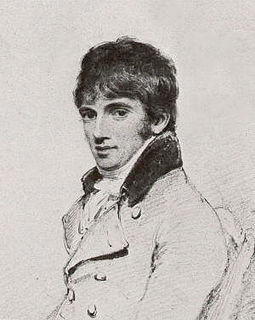
William Daniell (1769–1837) was an English landscape and marine painter, and printmaker, notable for his work in aquatint. He travelled extensively in India in the company of his uncle Thomas Daniell, with whom he collaborated on one of the finest illustrated works of the period – Oriental Scenery. He later travelled around the coastline of Britain to paint watercolours for the equally ambitious book A Voyage Round Great Britain. His work was exhibited at the Royal Academy and the British Institution and he became a Royal Academician in 1822.

Leyland railway station serves the town of Leyland in Lancashire, England. It was formerly "Golden Hill", the name of the street and area in which the station is based, but was renamed Leyland soon after opening. The original station was built in 1838, with two platforms.

Bamber Bridge railway station serves the area of Bamber Bridge, England 4 miles (6 km) to the south of Preston city centre on the A6 and M6 roads. It is situated on the East Lancashire Line and is managed by Northern.
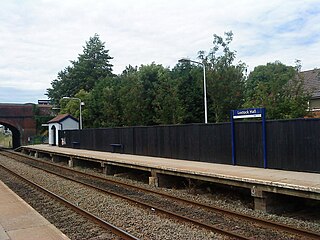
Lostock Hall railway station is 2 3⁄4 miles (4.4 km) south of Preston station, England. It is on the East Lancashire Line and is managed by Northern, who also provide all passenger trains serving it.
Farringdon may refer to several places in England:
The Ormskirk branch line is a railway line in Lancashire, England, running between Preston and Ormskirk. The train service is operated by Northern. The line is the northern section of the former Liverpool, Ormskirk and Preston Railway; the line from Ormskirk to Liverpool is now part of Merseyrail's Northern Line. Prior to the introduction of the 1970–71 London Midland Region timetable, it was a secondary main line from Liverpool to Scotland, Blackpool, and Yorkshire. From 4 May 1970, however, the line was severed at Ormskirk. With express trains eliminated, stopping services at the village stations en route were improved, and have retained a similar frequency to this day.

Farington railway station served Farington, south of Preston in Lancashire, England.

The River Lostock is a river in Lancashire, England.

Joseph Farington was an 18th-century English landscape painter and diarist.
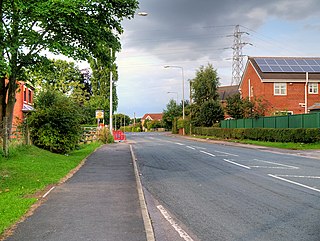
Farington Moss is a village approximately two miles to the north of Leyland, Lancashire, England. It is a typical English village with one school and one church. To the northeast of the village runs the main west coast railway line.
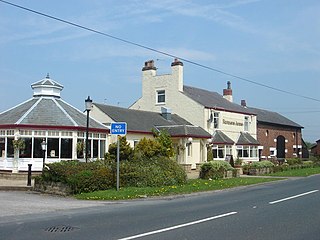
Whitestake is a small village in the South Ribble district of Lancashire, England. It is situated between Farington and New Longton, and is at the boundary of the parishes of Farington, Longton and Penwortham. It falls in what is called the "Western Parishes" area of South Ribble.
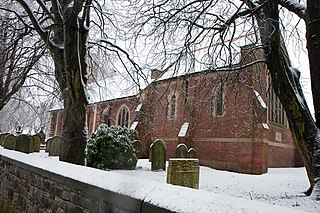
St Paul's Church is in the village of Farington Moss, Lancashire, England. It is an active Anglican parish church in the deanery of Leyland, the archdeaconry of Blackburn and the diocese of Blackburn. Its benefice is united with that of St James, Lostock Hall. The church is recorded in the National Heritage List for England as a designated Grade II listed building. It was a Commissioners' church, having received a grant towards its construction from the Church Building Commission.
Sir Richard Farington, 1st Baronet, was an English politician who sat in the English House of Commons between 1681 and 1701 and in the British House of Commons between 1708 and 1719.
Farington is a civil parish in the South Ribble district of Lancashire, England. It contains seven listed buildings that are recorded in the National Heritage List for England. All of the listed buildings are designated at Grade II, the lowest of the three grades, which is applied to "buildings of national importance and special interest". The parish is largely residential and contains the former villages of Farington and Farington Moss. The listed buildings comprise houses and associated structures, and a church.
Henry Farrington, of Farington, Leyland and Worden, Lancashire, was an English politician.














